

How's Life in the Digital Age? - Opportunities and Risks of the Digital Transformation for People's Well-being - en. This report documents how the ongoing digital transformation is affecting people’s lives across the 11 key dimensions that make up the How’s Life?
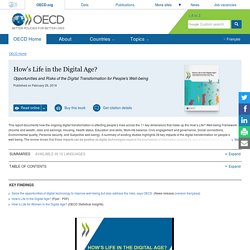
2Simple. 3 Steps to a More Accessible Classroom. "Turn on the subtitles, Ms.

Olague! " I clicked on the "CC" button underneath the YouTube video, and the closed-captioning appeared at the bottom of the screen. Suddenly, all my students were looking at the screen with wide eyes, eager to watch the video. In my first-grade classroom, a third of my students were learning English as a second language. 6 elements of a successful iPad implementation. By Samantha Messier and Stephanie Schroeder 11/17/2014 Topics: Mobile Learning, 1-to-1, Professional learning As more districts across the United States move to 1:1 initiatives, a common barrier is financial resources, and a common temptation is to regard these initiatives as technology enterprises rather than instructional transformations.
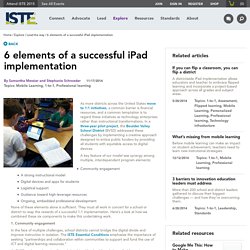
In a three-year pilot project, the Boulder Valley School District (BVSD) addressed these challenges by implementing a creative approach designed to entice public funders by providing all students with equitable access to digital devices. A key feature of our model was synergy among multiple, interdependent program elements: Community engagement A strong instructional model Digital devices and apps for students Logistical support Guidance toward high-leverage resources Ongoing, embedded professional development.
Computer Science Goes Beyond Coding. The “teach kids to code” movement has many thinking that computer science is just coding. Often the two are conflated since coding is definitely the most visible component of computer science. It is the magic that turns ideas into products; it provides the motivation to learn computer science. Kids want to learn so they can make cool stuff that is meaningful to them. However computer science goes beyond just coding. The K-12 standards for computer science, set by the Computer Science Teachers Association, defines the discipline as: “the study of computers and algorithmic processes, including their principles, their hardware and software designs, their applications, and their impact on society.”
CoSN: 7 Keys to unlocking school transformation with technology. Digital Technologies Hub. Digital Technologies Hub Scope and Sequences. What's this about?
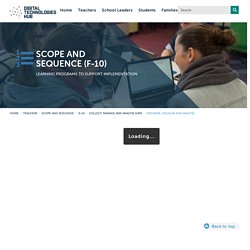
Students consider meaningful questions that they want to answer. They use these questions to apply their understandings about, and develop their skills of, data analysis and data visualisation. When acquiring data, students consider whether the data set is representative of the entire audience. Instructional Coaching and the Tech Coordinator. EdofICTJSSALC - SAMR Examples. Forget digital natives. Here’s how kids are really using the Internet.
Doug Chayka The era of the digital native is over.
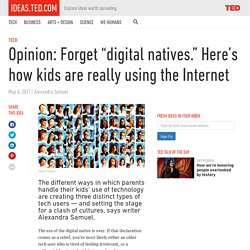
If that declaration comes as a relief, you’re most likely either an older tech user who is tired of feeling irrelevant, or a millennial frustrated with being reduced to a headphone-wearing cliché. In 2001, education consultant Mark Prensky coined this term — along with calling the analog-raised generation “digital immigrants” — to alert teachers to the emerging wave of students who’d be arriving at schools with new ways of thinking and absorbing information after growing up with computers, videogames, digital music players, video cams, cell phones and other devices. Future - How much is ‘too much time’ on social media?
#LikeMinded A special series about social media and well-being This month, BBC Future is exploring social media’s impact on mental health and well-being – and seeking solutions for a happier, healthier experience on these platforms.
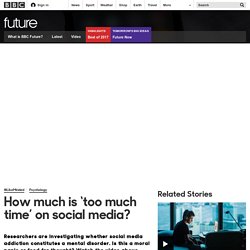
Stay tuned for more stories, coming soon… Share your tips for a happy life on social media with the hashtag #LikeMinded on Facebook, Twitter and Instagram. How to Effectively Introduce Coding and Computational Thinking into Your Classroom - The Learning Exchange. The inclusion of coding and computational thinking (CT) skills across all levels of education is gaining momentum worldwide.

Here at home, the Ministry of Education recently announced a focus on coding and CT skills in our Ontario schools. What follows are recommendations related to how large jurisdictions can adequately prepare our teachers to introduce and foster the development of coding and CT skills in our students. These recommendations draw on my experience teaching high school computer science and facilitating professional learning for both practicing and pre-service teachers. Information and Communication Technology (ICT) Capability - Learning continuum - The Australian Curriculum v8.1. Level 1 Typically by the end of Foundation Year, students: Recognise intellectual property recognise ownership over their own digital work Apply digital information security practices follow class rules about using digital information Apply personal security protocols.
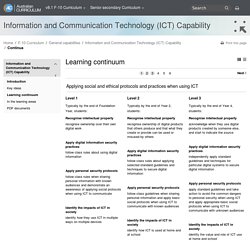
Integrating Computational Thinking into Your Elementary Classroom. By Grant Smith Computer science education is not a new field.
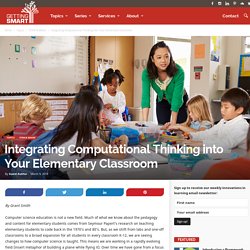
ISTE NETS Essential Conditions. 20-14_ISTE_Standards-S_PDF.pdf. 20-14_ISTE_Standards-T_PDF.pdf. SAMR: A Powerful Model for Understanding Good Tech Integration. The biggest obstacle to teaching online probably isn’t the technology.
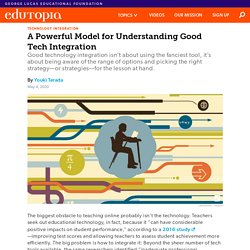
Teachers seek out educational technology, in fact, because it “can have considerable positive impacts on student performance,” according to a 2016 study—improving test scores and allowing teachers to assess student achievement more efficiently. The big problem is how to integrate it: Beyond the sheer number of tech tools available, the same researchers identified “inadequate professional development and training” as the primary obstacle to using technology productively in classrooms.
Startups Kano and Cubetto sell coding toys that teach children to become computer engineers. According to marathon-running mythology, Pheidippides, the ancient Greek athlete often named as history’s first endurance runner, dropped dead at the end of his run. Historians say this false dramatic detail springs more from poetry than traceable records, but the lie has likely endured because purposefully running 26.2 miles seems like a direct challenge to human limitations. The myth might be false—but it is plausible. Technology addiction executive summary. Tell me more about Makewaves. Makewaves is a safe social learning platform for schools. It offers schools a safe environment in which to publish blogs, videos, pictures, and audio online, where they can be shared with a like-minded network of schools around the world. Makewaves is free to join and every member school is given its own space within the community, where work can be safely published and shared. Teachers can choose their own security settings, giving them full control over who can view their school’s content.
Managing Technology: Tips from the Experts. MaturityModelBenchmarks2.5.pdf. National Center for Technology Planning. John See Technology Integration Specialist Minnesota Department of Education [Originally appeared in The Computing Teacher, Vol. 19, Number 8, May 1992] Contact information for John See -- unavailable as of Feb 2012 Effective technology plans are short term, not long term. National Education Technology Plan. The National Education Technology Plan is the flagship educational technology policy document for the United States. PadwheelposterV3.pdf. Pear Deck. The Practical Effect of Twitter Chats + Pedagogy Wheel. Many months ago I founded what would quickly become the largest Australian ‘ed-chat’ on twitter. The ‘#aussieED’ twitter chat runs on a Sunday at 8:30pm every Sunday night. Shortly after beginning, an awesome team began forming around me and together we have literally been able to reach tens of thousands of teachers across Australia using the twitter platform.
The speed of the take up has been outstanding and it has highlighted the fact that there is a genuine desire from classroom teachers to control their professional development and tailor their learning to allow them to provide tangible changes and improvements to the activities that teachers provide students in their classrooms. Technology Integration Matrix. A Technology Integration Planning (TIP) Model For Teachers. Technology Integration Research Review. TPACK.ORG. Virtual Reality in the Classroom: It’s Easy to Get Started.
Every teacher I know has virtual reality on their radar. What’s the Difference Between Coding and Computational Thinking? Twig - Blog: story. Teachers are constantly pushed towards new pedagogies in order to improve student performance. Educational Technology Applications. Web Literacy - Mozilla Learning.